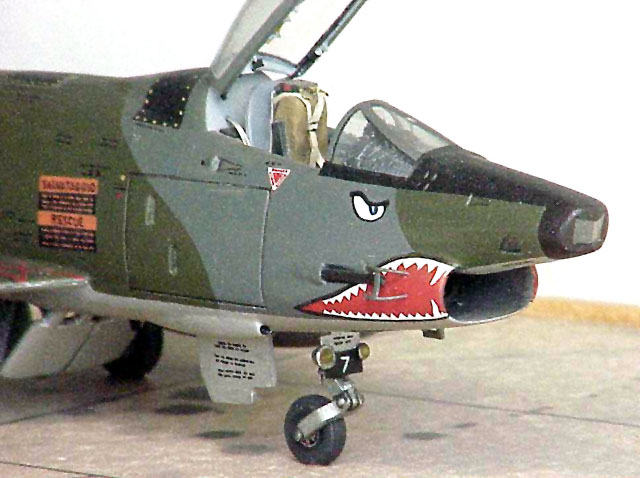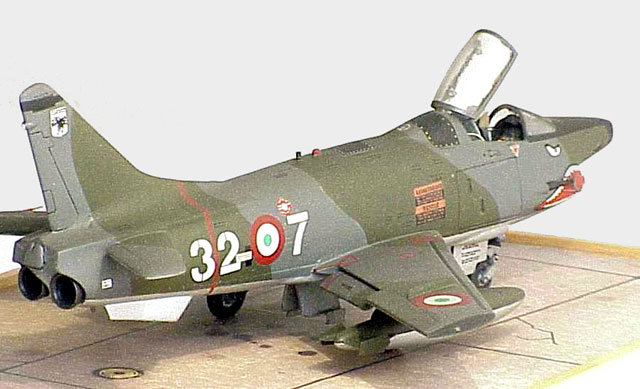|
Fiat G-91Y
by Andrea Mariottini
|

|
|
Fiat G-91Y |

HyperScale is proudly supported by
Squadron.com
This is the 1/72 scale Fiat G 91 Y produced by the
Italian "cottage company" Cunarmodel of the Gualdoni brothers (
www.cunarmodel.it ). It is a 22
year old model; I made it on leave during my military service in the
Italian Army between 1979 and 1980.
Well known in Italy for their aircraft desk models
and their aircraft color profiles published by the Italian Aviation
Research Branch and Aerofan magazines, the Gualdoni brothers also
produced a range of Aermacchi jet trainers.

After many years of absence, Cunarmodel is back
again on the shelves of the model shops with a range of Italian aircraft
made in resin; a new G 91 Y is part of the new range of resin kits.
The G 91 Y was a single-seat strike and
reconnaissance fighter, successor of the Fiat G 91 R. Due to the two
General Electric J85-GE13A turbojets, the G 91 Y possessed more power
and improved load-carrying capability.
But I do not want to tell the story of this
aircraft. The purpose of my article is to show the difference between
the today's available technology to make models and what was available
more than 20 years ago.
To make the Me 410 that appeared recently on
HyperScale I had the opportunity to use a very detailed kit with neatly
engraved panel lines, a photo etched sheet with tons of components,
resin and metal accessories, a vacuformed canopy, a dedicated decal
sheet, softening liquids for decals, acrylic colors, transparent
sealers, an airbrush, some kilos of documentation.
To make the G 91 Y I could use almost nothing
except the kit itself, a Microscale decal sheet for the Italian
roundels, a few photos on some magazines and a lot of inventiveness.
At that time (and maybe also today) the kit was
very good with detailed cockpit, cannon bay, separeted flaps and dive
brakes. It was produced by using a low pressure injection process; I
have been told by the Gualdoni brothers that the mould unfortunately
broke after a short time.
Many details have been hand made like the guns,
their protections, the lenses of the cameras, the seat belts and other
details in the cockpit.
The model has been hand-painted in the NATO
gray-green scheme on the upper-surface with Humbrol enamels. Since the
airbrushes were not easily available, my problem was how to paint the
lower surfaces in silver; the solution was found in a small tube of Rub
'n Buff silver paste. Do you remember it? It has been sufficient to thin
the silver paste with the Humbrol thinner, gently paint the lower
surfaces with a soft brush and the silver was done with a smooth finish.

As I mentioned before, the Italian roundels come
from a Microscale decal sheet. No other decals were available for this
aircraft so the 32 - 7 code were done with dry transfers of quite good
size and shape from Letraset; the shark-mouth, the eyes, the 32° Stormo
badge on the fin and all the stencils, walkways included, have been
hand-painted.
The model was sealed with a Letraset transparent
spray generally used to fix the dry transfers on the paper.
Some years later my model was finished, the
Matchbox's G 91 Y became available on the market. RCR's photo etched
sheet also became available. I think that now it should be much easier
to make a better G 91 Y model.
I do not want to make any comparison between today
and 20 years ago and I do not want to conclude what is better. I just
want to show to the young modellers and to remember to the old modellers
(like me) how we did work in the past.
What I can say for sure is that to make a model is
as entertaining for me today as it was in the past!
Click the thumbnails below
to view larger images:
Model, Images and Text Copyright © 2002 by
Andrea Mariottini
Page Created 23 December, 2002
Last Updated 04 June, 2007
Back to HyperScale
Main Page
Back to
Features Index
|
Home
| What's New |
Features |
Gallery |
Reviews |
Reference |
Forum |
Search